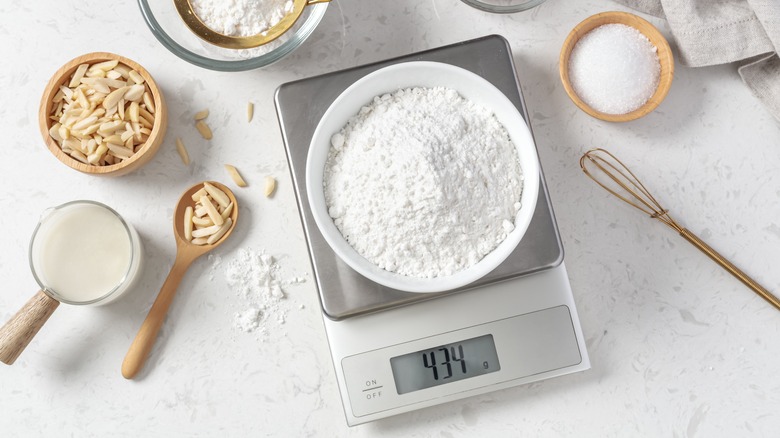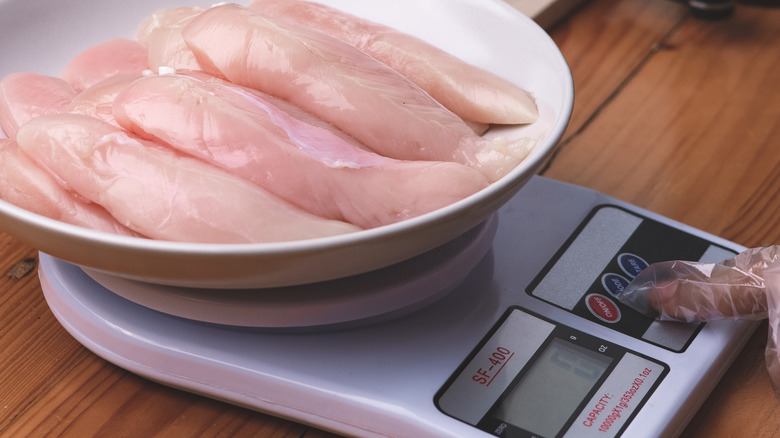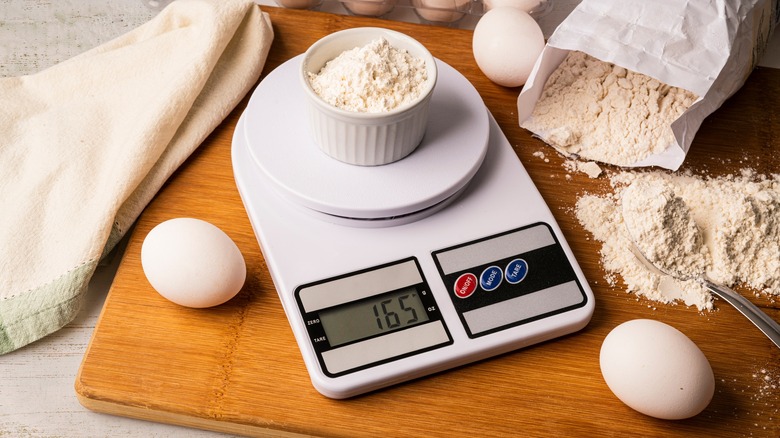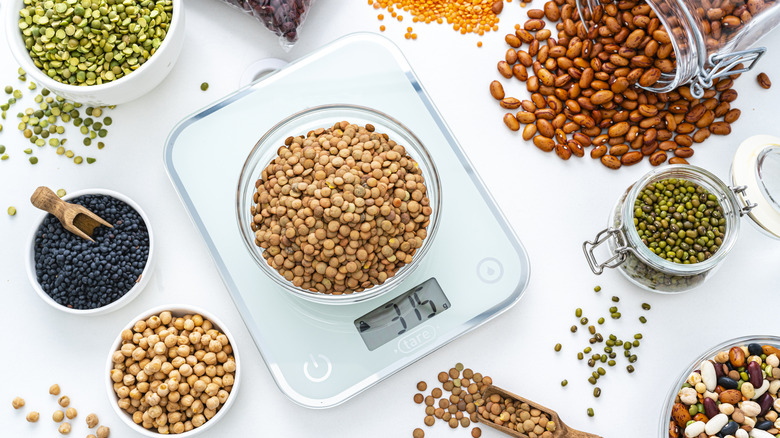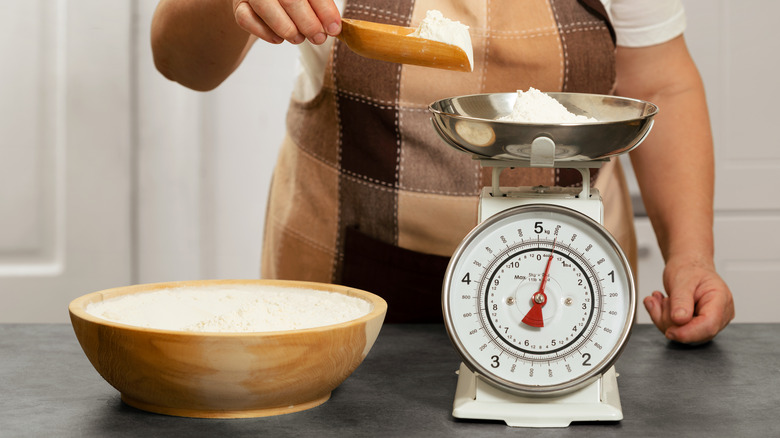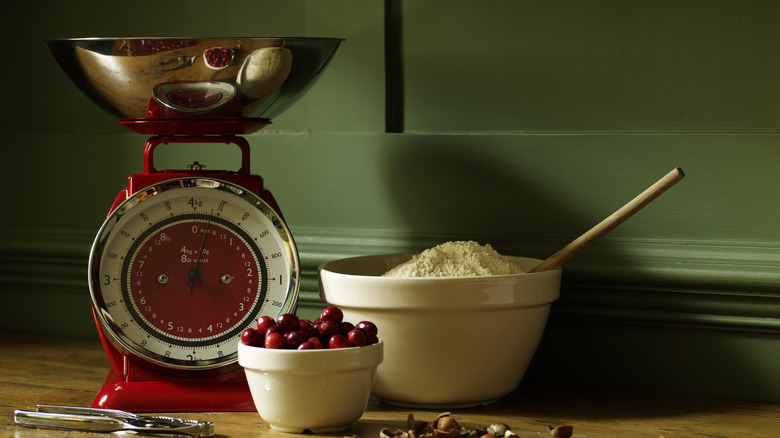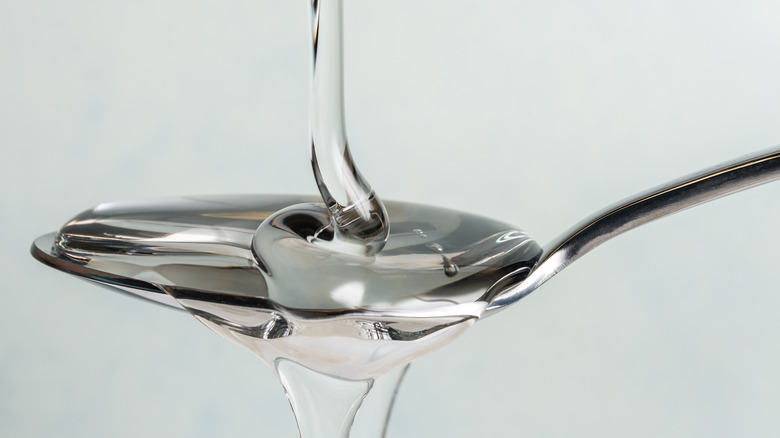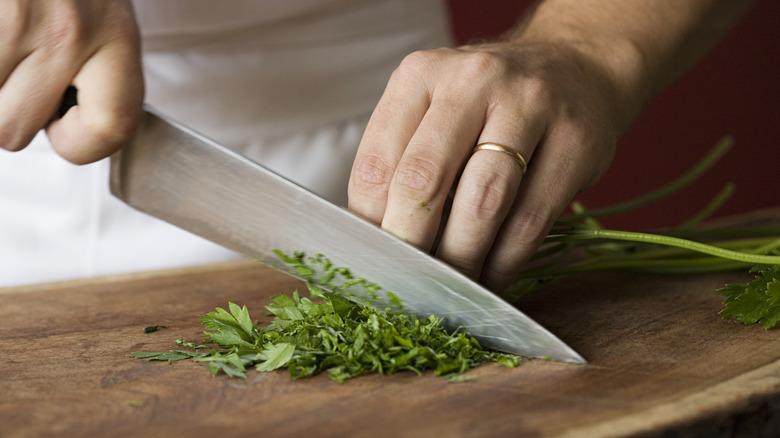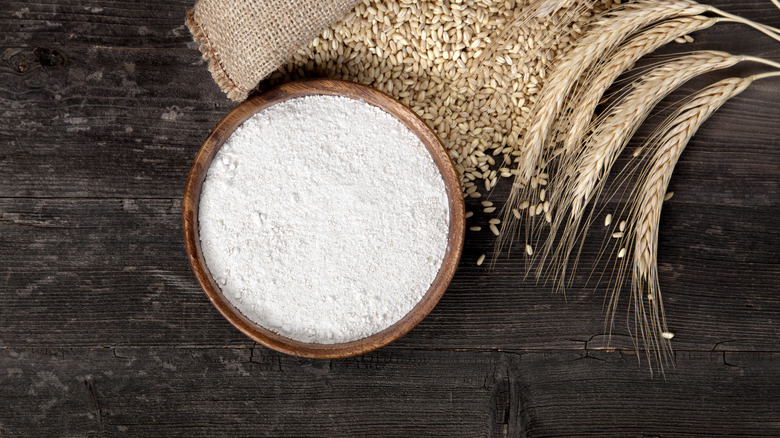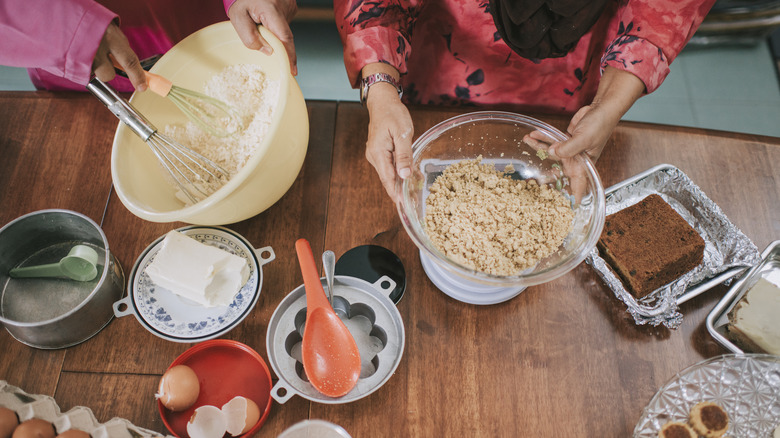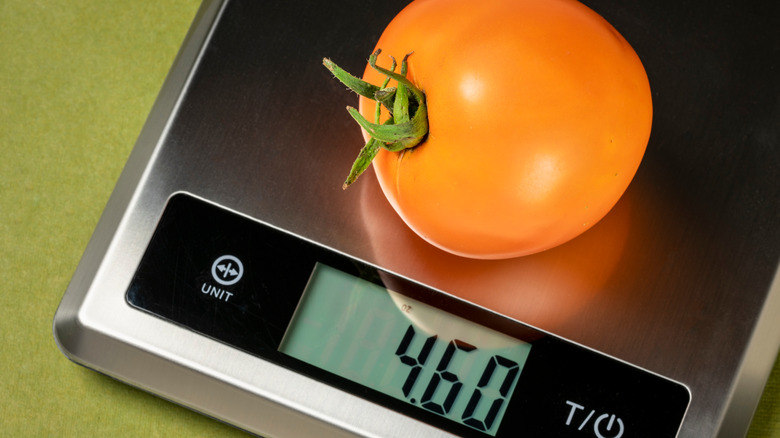Mistakes Everyone Makes When Using A Kitchen Scale
The humble set of kitchen scales is probably one of the most useful culinary inventions of all time. Kitchen scales take the guesswork out of measuring ingredients, and instead allow you to pinpoint the ratios of your recipe's elements with total accuracy. By using kitchen scales to measure dry goods like flour or sugar, you can avoid volume-related issues that can occur when you're scooping out your ingredients inconsistently or inadvertently trapping air in your measuring cups. It also lets you sidestep any irregularities in your measuring vessels, and instead reduces your recipe to cold, hard numbers, which are the same every single time.
Using kitchen scales is also an excellent way to keep your kitchen clean: Rather than be left with a dozen different measuring cups that all need cleaning up, you just have to throw one or two items in your dishwasher. All sounds pretty good, right? Well, the only problem with kitchen scales is that they're surprisingly tricky to get right. With one wrong press of a button or incorrect placement, you can end up with a wrong measurement, leaving your recipe redundant. Instead of accidentally ruining your hard work, you can just learn from our mistakes instead. Then you can use your scales in your cooking and thank us later.
Mistake: Forgetting to tare your scales
If you've ever wondered what "tare" means on your scales, we're about to reveal all. The tare function is used to remove the weight of an item you don't want to include in your overall recipe, like the bowl you're using to place all your ingredients in. This is commonly confused with the "zero" function, which, as you've probably figured out, reduces your scales' measurement to zero — but taring your scales is usually more accurate, and allows you to keep track of your weights more precisely as you go.
Too many people, however, forget to tare their scales, both at the beginning of their weighing process and as they're adding successive ingredients. This can lead to some tricky calculations having to be done on the fly, and a potentially inaccurate result. To tare your scales, first put your container on the weighing pad, and then press the tare button. Your scales should eliminate the weight of your bowl, reducing it to zero. You then need to tare your scales after you add each ingredient, which allows you to precisely weigh every item separately every time, without needing to remove your bowl and use a new one.
Mistake: Not familiarising yourself with its instructions
Kitchen scales may seem simple, but there's often a lot more to them than you might think — and too many people assume that they've got a handle on their new machine, without figuring out its instructions first. They then start weighing out their items, press the wrong button entirely, and end up having to throw out a full bowl of ingredients, having totally lost track of their measurements, or may even realize they've been using the wrong weight unit. Not fun, huh? That's why you should always take time to discern how your machine works. Most kitchen scales, thankfully, are equipped with just a few buttons: A power button that turns the appliance on and off, a mode or conversion button that changes grams to pounds and ounces and vice versa, and a tare button to remove weight.
Some kitchen scales may also have a percentage button. This will convert whatever weight is on your scales to the 100% point, which you can then use as a benchmark for other ingredients. This is a slightly more complicated way of weighing things which is usually most useful for making bread, and is probably most useful for more advanced bakers. If you have any doubts about how your kitchen scales operate, always refer to your instruction manual.
Mistake: Placing your scales on an uneven surface
The whole point of using kitchen scales is to get as accurate of a measurement as possible. The surface you place your scales on, though, can significantly impact this. If your scales are on a bumpy, slanting, or soft surface, they can give you a pretty inaccurate reading. The reason for this boils down to simple physics: Place your scales on something uneven, and they won't be able to feel the full downward gravitational pull of the object as accurately, making your item often seem lighter than it is. Unevenness can also cause your items to slip off the scales entirely, resulting in spillages and a lot of mess.
To rectify this is simple enough — just make sure your scales are placed flat on your kitchen surface. Remove any items underneath that could cause obstruction or unevenness, like kitchen towels, and check for any debris under the scales that could have been lodged under one of its legs. If there's nothing under your scales and you're still getting an inaccurate read, it might be worth checking whether your kitchen surface itself is level. Use a spirit level to assess whether your surface is lying flat, and if it isn't, move your scales to a different place.
Mistake: Forgetting that you can adjust its units of measurement
Not everyone uses the same units of measurement. You might find, for example, that you're working with a recipe that uses grams instead of ounces and pounds, or more confusingly, a recipe that incorporates different units in the same ingredients list. When this happens, you can find yourself scrabbling for an online measurement converter on your phone with flour-covered hands, or worse, trying to figure it out in your head, often with disastrous results.
That little button on your digital scales, though? It'll change your measurements in a jiffy. Just press the "mode" button on your kitchen scales (which can sometimes be labeled as the "unit" button), pick the one you want to work with, and start weighing. Just make sure you select the right unit of measurement at the beginning and stick to it. While you can change them halfway through, getting everything set up beforehand will prevent you from having to make hurried changes halfway through. If your recipe is using two different units of measurement, we'd recommend weighing each portion of ingredients out separately in two shifts, before combining them.
Mistake: Choosing the wrong kitchen scales for your needs
We all want to make sure that we have the right utensils for the recipe at hand, but sometimes we can stick with items that we just know don't work. This is particularly common when it comes to kitchen scales, which most people only use now and again. Choosing and using the wrong kitchen scales, though, can often leave you stuck in a pinch, and having to wrangle with an appliance that may be too big or too small for your recipes or bowls.
While mechanical scales used to be the norm, nowadays we generally always recommend using digital kitchen scales. These are relatively inexpensive and are way easier to read than a mechanical scale, which is easy to misread from the wrong angle. Digital scales also tend to be more robust and are less subject to individual parts breaking. It's worth remembering, however, that digital scales require batteries to operate, whereas mechanical ones don't — and if you're the kind of person who always forgets to buy new ones, this can leave you stuck.
Size-wise, we would recommend thinking about what you're going to use your scales for. If you're making massive batches of baked goods, you might want to get a larger scale that has a higher weight limit and platform for your bowl. If you're an amateur baker, though, you can probably get away with a smaller model.
Mistake: Not thinking about your environment
You might not think it, but your environment can have a pretty big effect on your recipes, especially when you're baking. Altitude and humidity can change how much your ingredients weigh, with humidity in particular sometimes doubling the weight of dry ingredients. There are many different types of flour, for example, and all of them will take on more water when there's a high level of moisture in the air. This, in turn, makes them bigger and heavier when compared to the same amount in a drier environment.
Failing to consider this can be ruinous when using kitchen scales, and not for the reason you might think. Kitchen scales are, luckily, somewhat immune to this, because measuring by weight is more accurate than measuring by volume. However, what can happen in these situations is that you start to second-guess the accuracy of your scales, especially if the quantities look noticeably different from the last time you made your recipe when compared to their weight. Instead, just trust your scales, and disregard the volume, unless you know that your kitchen scales are faulty.
Mistake: Not using your kitchen scales to weigh liquids
Weighing dry goods somehow feels more logical than doing so with wet ingredients, and as a result, people tend to split up their items and use two different methods: Scales for the dry ones, measuring cups for the wet ones. However, this can lead to a very inconsistent result, especially if you're working with the imperial system of pounds and ounces. While we commonly think that fluid ounces and ounces convert to each other seamlessly, that's not entirely the case.
There are only a few liquids that are effectively the same in ounces as they are in fluid ounces: Water, oils, and milk, with eggs also converting like-for-like. Everything else, however, doesn't do so as easily. Molasses, corn syrup, and different types of honey are all much denser than water, and so weigh more for the same volume. If you assume that the two ounces of corn syrup in your decadent sauce recipe can be subbed out for two fluid ounces, you'll end up with a dish that tastes way off. So, just weigh everything in your recipe, and make your life easier. The only exception to this is if your recipe specifically states that you should be using a fluid ounce measurement for any particular ingredients.
Mistake: Using your kitchen scales to weigh absolutely everything
Once you get yourself a good set of kitchen scales, it's easy to never look back. However, while they can certainly make your life simpler, it's easy to overdo things. We would advocate using your kitchen scales to measure most items in a recipe, but certain items are simply better for being portioned out with cups or spoon measurements.
If you're using fresh herbs and dry herbs (or spices), for example, we would always recommend using measuring cups. For one thing, the quantities that you're usually using these ingredients in are so small that it feels a bit pointless to bust out the kitchen scales for them — and besides, if your scales aren't sensitive enough, they may not even pick up the amount you're using, causing you to overdo it to try and get them to activate. There's also a certain abandon and fun that comes with scattering an over-generous portion of fresh parsley or cilantro over a meal that kitchen scales somewhat take away from. If your recipe is calling for a small amount of salt or pepper, too, it's easier just to use a measuring spoon.
Mistake: Forgetting to measure your ingredients roughly before weighing them
So, you've got your kitchen scales out, placed your bowl on top, and you're good to go. Then you take your giant bag of flour out of storage, pour it in ... and your hand slips. The flour goes everywhere, your measurements are already out of whack, and you haven't even got started. Hardly fun, right?
This is easily avoided by doing a rough measurement of all of your ingredients before you add them to your scales and prep them; an easy trick is to place each one in an easy-to-reach vessel. By doing this, you can keep mess to a minimum, and you also get to be more precise with your additions, with better control when adding them in. This move is also a great way for you to assess that you have all the ingredients you need before you start cooking.
Additionally, doing this can help you avoid significantly over-adding ingredients. If you're adding wet ingredients to dry, it's easy to overdo it, adding way too much from a free-flowing bottle and then completely losing track of how much of your dry ingredients you need to add to balance it out. Pouring out your liquids beforehand, though, will give you greater accuracy.
Mistake: Overloading your kitchen scales
Kitchen scales are built to be robust, but they're not indestructible. This is a key distinction that a lot of people don't think about when they're making a weeknight meal prep recipe or anything else that requires large quantities. If you're not careful, you could add too many ingredients to your super-size mixing bowl, there's an unsettling crack, and you find that your kitchen scales have been overloaded, and are now beyond repair — or otherwise, you find that they simply stop reading the weight altogether, having reached their maximum load.
This can be easily avoided by checking the weight limit of your scales first. Many kitchen scales have a weight limit of around 11 pounds (5 kilograms), after which they'll stop reading extra additions. Some scales are equipped to take heavier weights and will measure up to twice that much. Luckily, many digital scales will have an alert on their displays which will tell you when you're nearing the limit, and mechanical scales will have their limit displayed on the front dial. If you're in any doubt, check your manufacturer's instructions for more information. It's also important to remember that scales have minimum weights they're able to measure. Most scales can easily measure a minimum of 1 ounce (28 grams), but others can easily measure as little as 0.07 ounces (2 grams).
Mistake: Forgetting that kitchen scale measurements can drift
Scales are made to be reliable, but that doesn't mean that they'll never change. Over time, kitchen scales can suffer from a drift effect, where the readings they show become more and more different from the true weight of the objects. This is down to a few factors that may be simply due to a change in temperature or air pressure, but can potentially flag that the inner mechanism of your scales is deteriorating
Regardless of the cause, once a scale drifts, it may not drift back in the same direction. You'll need to recalibrate your scales to reset them. On digital scales, this can usually be done by holding down one of the buttons until it enters a recalibration setting, or selecting the recalibration function with the "mode" button, and then recalibrating the scales by weighing an item on them. The process can vary from model to model though, so check your instruction booklet. Recalibrating manual scales is slightly simpler, and is usually just done by readjusting the dial so the needle points straight at zero when there's no weight on it.
